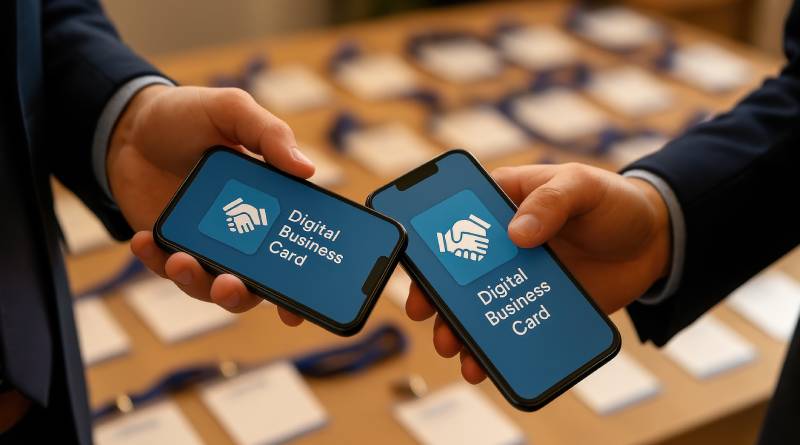A digital business card is an easy way to share contact details without printing anything. It helps people connect fast and keeps information neat and updated. Many people like it because it’s simple to make and works on any device. It also saves time since it only takes a few minutes to set up.
This guide explains how to create one with clear steps anyone can follow.
Table of Contents
ToggleWhat Is a Digital Business Card?
A digital business card is an online version of a traditional physical card. It can hold a name, phone number, email, website links, and social profiles. Some cards also include a short bio, a photo, or a QR code. Instead of handing someone a piece of paper, a user shares a link or lets others scan the code. It’s convenient and easy to update at any time.
People use smart digital business cards because they stay current. A printed card becomes outdated once details change, but a digital card can be edited in seconds. This helps students, professionals, business owners, and freelancers keep their contact details correct without reprinting anything.
Why Use a Free Digital Business Card?
A free digital card is a smart choice for anyone who wants a clean and professional look without paying for design tools. Many websites offer free templates and simple editors, so there’s no need to learn design skills.
People also like the quick sharing options. For example, a small business owner can text a link to a customer. A consultant can show a QR code at an event to let others save their information instantly. These small actions help make networking less awkward and more efficient.
Free digital cards also support simple branding. Users can pick colors, fonts, and layouts that match their style or workplace. Even a basic card can look polished with the right design.
Step 1: Choose a Platform
There are many sites and apps that let users create a free digital business card. They all offer templates and simple tools for editing.
When choosing a platform, it helps to look for:
- A simple and clean interface
- Templates that match the user’s personality or brand
- Sharing options like links, QR codes, or images
- Easy ways to edit the card when details change
Beginners usually benefit from tools that have clear buttons and instructions. A simple layout helps avoid confusion and speeds up the process.
Step 2: Prepare the Information
Before designing the card, it’s helpful to gather the details that’ll appear on it. The card should be clear and easy to understand. Most people include:
- Full name
- Job title
- Company or business name
- Phone number
- Email address
- Website or portfolio link
- Social media accounts
- A photo or logo
Not every card needs a lot of information. A graphic designer might add a portfolio link, while a local service provider might focus on a phone number and email. Keeping it simple makes the card more effective.
Step 3: Design the Card
After choosing the platform and gathering the details, the next step is to customize the design. Templates help with layout, so anyone can create a clean and balanced card.
Here are a few helpful design tips:
- Use fonts that are easy to read
- Pick two or three colors to keep the card neat
- Keep enough space between text sections so the card doesn’t look crowded
- Use a clear and bright photo or logo
Many people prefer a simple look because it appears professional and works well on both phones and computers.
Step 4: Add a QR Code
A QR code makes the card even easier to share. Most free platforms create one automatically. Users can save the QR code and place it on posters, packaging, event signs, or printed cards.
People can scan the code with their phones and view the digital card instantly. This saves time and reduces errors since they don’t need to type anything.
Step 5: Review and Test Everything
It’s important to check the card before sharing it. Testing the links helps confirm that email, phone numbers, websites, and social profiles open correctly. It’s also a good idea to view the card on different devices.
If something looks cluttered or hard to read, adjusting the layout can help. A short review prevents mistakes from appearing during a first impression.
Step 6: Share the Card

Once the card is ready, it can be shared in many simple ways:
- Sending the link through text or messaging apps
- Adding it to the email signature
- Sharing the QR code at events
- Posting it on social media
- Placing it on a website or online profile
These methods help others save contact details quickly. It also keeps information organized for future conversations.
Helpful Tips for Beginners
People who are new to digital cards often wonder how to make them more useful. These tips help:
- Update the card when details change
- Keep the design clean and simple
- Use the same colors and style for consistent branding
- Track how often the card is viewed if the platform offers that feature
These small habits can make the card look more professional and more effective in daily use.
Conclusion
A free digital business card is a quick and simple way to share contact information without printing anything. It’s easy to set up through user-friendly platforms and only takes a few minutes to build. A clean layout and accurate details help make the card easy for others to save. These steps guide beginners through the entire process, from choosing a platform to sharing the final card. Anyone can create a polished digital business card with very little effort.
Also Read: How Mobile-First Design Changed the Rules for Text Editing Interfaces
How to Create a Free Digital Business Card in Minutes: A Simple Tech Guide
Shashi Teja
Related posts
Hot Topics
How to Create a Free Digital Business Card in Minutes: A Simple Tech Guide
A digital business card is an easy way to share contact details without printing anything. It helps people connect fast…
Best Free Video Editor for Instagram Reels: Stop Settling for Mediocre Content
So I was filming a Reel last week—just something random in my kitchen—and I realized halfway through that the lighting…



